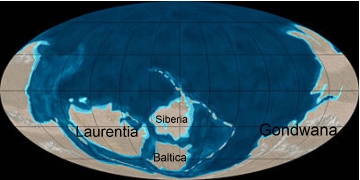Paleogeography
Reconstructions of Cambrian geography
 suggest
that a global supercontinent,
Pannotia, was in the process of breaking up,
with
Laurentia (North
America) and
Siberia having
separated from the main mass of the
Gondwana supercontinent to form isolated
landmasses. Most continental land mass was
clustered in the southern hemisphere.
suggest
that a global supercontinent,
Pannotia, was in the process of breaking up,
with
Laurentia (North
America) and
Siberia having
separated from the main mass of the
Gondwana supercontinent to form isolated
landmasses. Most continental land mass was
clustered in the southern hemisphere.
With a lack of sea ice – the great glaciers of the
Marinoan
Snowball Earth were
long melted – the sea level was high, which led
to large areas of the continents being flooded in warm, shallow seas ideal
for thriving life. The sea levels fluctuated somewhat, suggesting that there
were 'ice ages', associated with pulses of expansion and contraction of a
south polar ice cap.
Stratigraphy
Two schemes
exists for the stratigraphy of the
Cambrian period. The supposedly
international (i.e. Western) ICS scheme is in a state of flux, and does not
yet have any firmly established internal boundaries, although it has set a
stratotype section for the base of the Cambrian, dated quite accurately to
542 ± 0.3 million years ago. In contrast, the Russians and many Chinese
scientists prefer a different scheme; since the most significant exposure of
Cambrian strata lies in these countries, they are arguably better placed to
determine subdivisions.
Stratigraphy relates to the order of rock units, without referring to their
absolute ages (which is chronology). However, because fossils - which are
traditionally the cornerstone of stratigrapahy - are relatively rare in the
Cambrian, chronology has a significant part to play; if an absolute age can
be obtained with a high degree of accuracy for different strata, their
relative age can also be established.
The base of the Cambrian is
officially defined as the first appearance of a certain trace fossil,
Treptichnus pedum.
However, this fossil has recently been found in older rocks than the
locality which officially marks the start of the period. However,
there is a period of biological change which makes this time period a good
one to demarkate the Cambrian and Precambrian: consensus holds that fossils
of the
Ediacara biota
disappear here, as do some shelly fossils and acritarchs; and a new
small shelly fossil
biota emerges.
Life
The Cambrian
is unique in its unusually high proportion of
lagerstätte. These are sites of exceptional
preservation, where 'soft' parts of organisms are preserved as well as their
more resistant shells. This means that, paradoxically, our understanding of
the Cambrian life surpasses that of later periods.
The Cambrian period marked a
profound change in life on Earth. Before the Cambrian, life was on the whole
small and simple. Complex organisms became gradually more common in the
millions of years immediately preceding the Cambrian, but it wasn't until
this period that mineralised (hence readily fossilised) organisms became
common. This diversification of lifeforms was relatively rapid, and is
termed the
Cambrian explosion.
This explosion produced the first representatives of most modern phyla, but
on the whole, most Cambrian animals look alien to today's eyes, falling in
the evolutionary stems of modern groups. While life prospered in the oceans,
the land was barren - with nothing more than a microbial 'crud' gracing the
soils. Apart from tentative evidence suggesting that some animals floundered
around on land, most of the continents resembled deserts spanning from
horizon to horizon. Shallow seas flanked the margins of several continents,
which had resulted from the relatively recent breakup of the preceding
supercontinent
Pannotia. The seas were
relatively warm, and polar ice was absent.
End of Reading
![]()
Return to the Old Earth Ministries Online Earth History Curriculum homepage.
![]()
Source Pages: Cambrian Period, Stratigraphy of the Cambrian